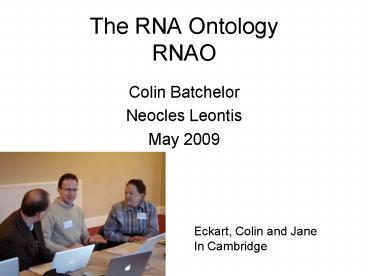The RNA Ontology RNAO - PowerPoint PPT Presentation
1 / 14
Title:
The RNA Ontology RNAO
Description:
Commitment to common upper ontology (BFO) ... alignment and phylogeny (Rob Knight) Rfam (Alex Bateman) 2D to 3D structure (Alain Laederach) ... – PowerPoint PPT presentation
Number of Views:44
Avg rating:3.0/5.0
Title: The RNA Ontology RNAO
1
The RNA OntologyRNAO
- Colin Batchelor
- Neocles Leontis
- May 2009
Eckart, Colin and Jane In Cambridge
2
RELATION TO TIME GRANULARITY CONTINUANT CONTINUANT CONTINUANT CONTINUANT OCCURRENT
RELATION TO TIME GRANULARITY INDEPENDENT INDEPENDENT DEPENDENT DEPENDENT
ORGAN AND ORGANISM Organism (NCBI Taxonomy) Anatomical Entity (FMA, CARO) Organ Function (FMP, CPRO) Phenotypic Quality(PaTO) Biological Process (GO)
CELL AND CELLULAR COMPONENT Cell (CL) Cellular Component (FMA, GO) Cellular Function (GO) Phenotypic Quality(PaTO) Biological Process (GO)
MOLECULE Molecule (ChEBI, SO, RNAO, PrO) Molecule (ChEBI, SO, RNAO, PrO) Molecular Function (GO) Molecular Function (GO) Molecular Process (GO)
OBO Foundry http//obofoundry.org
2
Smith et al. Nature Biotechnology 2008
3
Relationship of RNAO and neighboring ontologies
- ChEBI (Chemical Entities of Biological Interest)
- Sequence Ontology
- Gene Ontology
RNAO
ChEBI
Sequence Ontology
Relations Ontology Basic Formal Ontology
4
RnaO and OBO
- Commitment to common upper ontology (BFO)
- Commitment to dividing responsibilities between
ontologies - ChEBI for molecular parts (and relations?)
- SO for sequences
- GO for RNA function
- Leaving RnaO to concentrate on RNA
5
Aim
- to create a common, dynamic, controlled
vocabulary (the RO), pertaining to RNA function
and based on RNA sequences, secondary and
three-dimensional structures. Thus, the central
objective of the ROC is to identify all RNA
features, interactions and motifs mentioned in
the literature or appearing in databases, to
agree upon a definition for them and to write
that definition down in a structured manner. This
is very timely as knowledge about RNA accumulates
and progresses rapidly. The purposes for creating
the RO are therefore (1) to integrate sequence
and structural databases and (2) to create
powerful software tools that bring advanced
computational methods to the bench scientist.
6
RNAO Working Group meeting in Cambridge, UK,
January 2009
- Presentations on
- RNAO in OWL (Colin Batchelor)
- Conformations (Jane Richardson)
- reasoning (Chris Mungall)
- formal ontology (Thomas Bittner)
- SO (Karen Eilbeck)
- ChEBI (Kirill Degtyarenko)
- alignment and phylogeny (Rob Knight)
- Rfam (Alex Bateman)
- 2D to 3D structure (Alain Laederach)
7
Existing neighbouring ontologies
- Sequence Ontology
- (5 base pair terms, 3 pseudoknots, 2 stem loops,
10 motif terms) - ChEBI
- (4 RNA terms)
- Gene Ontology
- (functions performed by ncRNAs)
8
RNAO v1.0
- Implemented in OWL
- (easier to write complicated logical definitions
in Protégé than in OBOEdit but less powerful than
FOL and names and really not suitable for
human-readable definitions and synonyms) - gt100 classes
- gt20 relationships
9
Simple use cases
- Classify base pairs according to the
Leontis-Westhof scheme (easy) - Identify motifs in 3d structures (hard going on
impossible) - (Vaguer, but really the most important) Provide
bridge between different representations
10
Base pair classification (1)
- First attempt use relations to express pairing,
bonding and so forth (Dumontierian approach) - Base pairing
- pairsWith, pairsWithWW, pairsWithCWW
- Backbone bonding
- fivePrimeTo, threePrimeTo, etc.
11
Base pair classification (2)
- Then (OWL Manchester syntax)
- Family1BasePair hasPart some Nucleobase and
(pairsWithCWW some Nucleobase) - (this works and classifies base pairings
satisfactorily within the LW scheme)
12
(No Transcript)
13
Drawbacks
- OWL cannot handle motifsthey require a larger
subset of first-order logic - But RNA experts differ on definitions of motifs
anyway! - RNAO.owl hides the interactions behind a large
set of relations - Relations are hard to maintain in Protégé/OWL
14
Next steps
- Integrate with real RNA data (NDB, FR3D)
- Collect RNA motif definitions
- Formalize what we are actually hiding behind the
relations - (WC edge, etc. are parts of nucleotides and have
a topological relation to other edges) - Base pairs are parts of RNA molecules
- Basebase, basephosphate and stacking
interactions should be treated in the same way as
we handle covalent bonds































